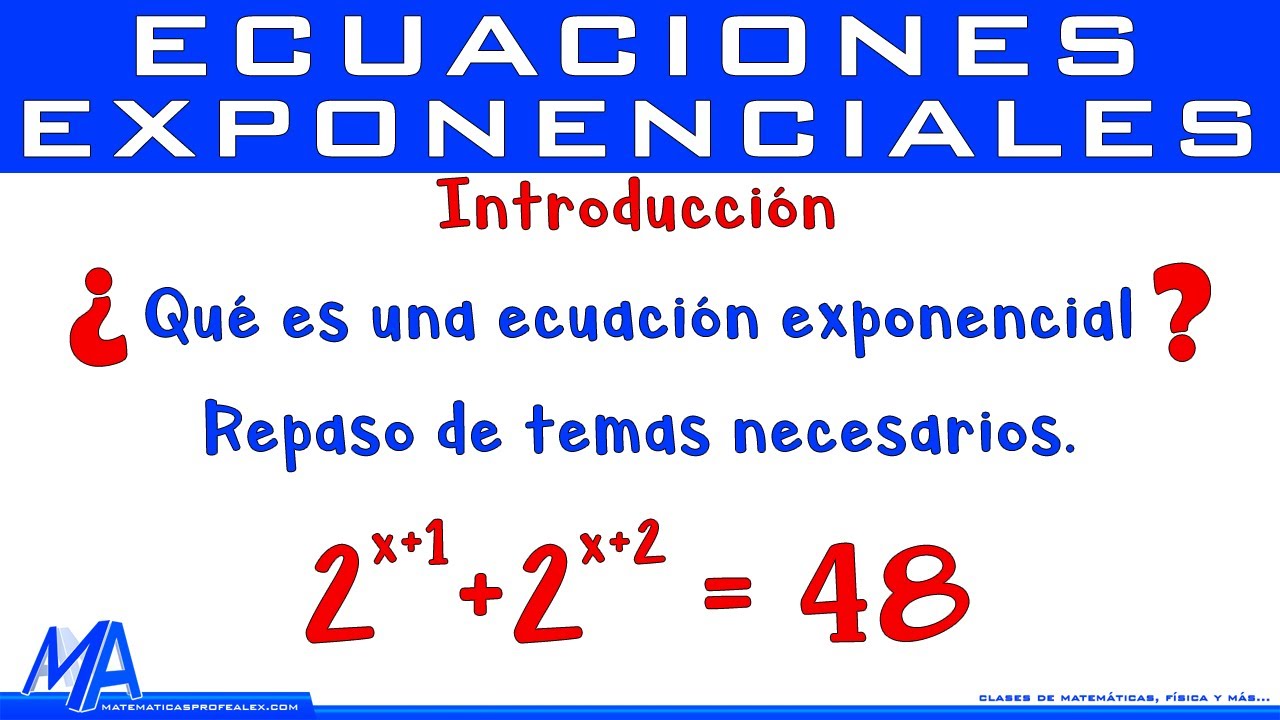Matematika SMA - Persamaan Eksponen (1) - Bentuk Dasar a^f(x) = a^p
Summary
TLDRIn this video tutorial on exponential equations and functions, viewers will learn how to solve equations with the same or different bases, using exponent rules and transformations. The tutorial covers various examples, including handling fractions, roots, and equations set equal to 1. Key concepts such as base matching, exponent manipulation, and solving quadratic equations are explained with clarity. By the end, viewers will have a solid understanding of exponential functions and how to graph them, making it an essential resource for math learners and enthusiasts.
Takeaways
- 😀 The video introduces a series on equations and exponential functions, focusing on various forms and how to process them, including graphing.
- 😀 Viewers are encouraged to subscribe to the channel and explore additional videos for a more comprehensive understanding of equations and exponential functions.
- 😀 The video highlights the three levels of channel membership: Linear, Quadratic, and Cubic, each with its own advantages.
- 😀 The basic form of an exponential equation is presented as a^f(x) = a^p, where 'a' is the base and 'p' is a constant number, such as integers or fractions.
- 😀 When the base of the exponential equation is the same, the exponents can be set equal to each other to solve for x.
- 😀 In cases where the base numbers differ, the strategy is to express them as powers of a common base (e.g., 8 = 2^3) to make them the same.
- 😀 Exponent properties, such as multiplying exponents or expressing roots as fractional exponents, are key tools for solving exponential equations.
- 😀 A quadratic equation can emerge from solving an exponential equation, and viewers are reminded of how to solve quadratic equations from junior high school.
- 😀 The script demonstrates how to handle fractions and roots in exponential equations, using basic exponent rules to simplify the expressions.
- 😀 The concept of exponents with a base of 1 is discussed, and the video clarifies how any non-zero number raised to the power of 0 equals 1, helping solve specific equations.
- 😀 Viewers are encouraged to share the video with others and follow the channel’s Instagram for further learning opportunities.
Q & A
What is the main topic discussed in the video?
-The video focuses on teaching about equations and exponential functions, including different forms of exponential equations and methods for solving them.
What is the basic form of an exponential equation mentioned in the video?
-The basic form of an exponential equation is expressed as a^f(x) = a^p, where 'a' is the base, 'f(x)' is a function in x, and 'p' is a number.
How do you solve an exponential equation when the base numbers are the same?
-When the base numbers are the same, you can directly equate the exponents to find the solution for x. For example, if 3^(x-2) = 3^4, you equate x - 2 = 4, and then solve for x.
What should you do when the base numbers are different in an exponential equation?
-If the base numbers are different, you should first try to express both sides of the equation with the same base, using exponent rules, and then solve the equation.
In the example '2^(4x+1) = 8^(1/3)', how are the base numbers made the same?
-The number 8 is rewritten as 2^3. Then, 8^(1/3) becomes (2^3)^(1/3), which simplifies to 2^1. This allows the equation to have the same base on both sides.
What method is used to solve the equation '3^(x^2 - 6x) = 1/243'?
-243 is expressed as 3^5. Then, both sides of the equation are written with the same base (3), allowing the exponents to be equated and solved as a quadratic equation.
How do you factorize a quadratic equation like 'x^2 - 6x + 5 = 0'?
-To factorize 'x^2 - 6x + 5 = 0', you need to find two numbers that multiply to 5 and add to -6. These numbers are -5 and -1. Therefore, the factorization is (x - 5)(x - 1) = 0.
What happens if an exponential equation equals 1?
-When an exponential equation equals 1, the exponent must be zero because any number raised to the power of 0 equals 1. This is used to solve equations like '64^(x^2 - 4x - 12) = 1'.
How do you handle roots in exponential equations?
-If the equation involves roots, such as 'a^(1/2)', you can rewrite the equation as 'a raised to a power'. For example, if you have a square root, you rewrite it as the power 1/2.
What is the solution set for the equation 'x^2 - 6x - 12 = 0' in the context of exponential functions?
-The solution set for the quadratic equation 'x^2 - 6x - 12 = 0' can be found by factoring or using the quadratic formula. In this case, the solutions are x = 6 and x = -2.
Outlines

This section is available to paid users only. Please upgrade to access this part.
Upgrade NowMindmap

This section is available to paid users only. Please upgrade to access this part.
Upgrade NowKeywords

This section is available to paid users only. Please upgrade to access this part.
Upgrade NowHighlights

This section is available to paid users only. Please upgrade to access this part.
Upgrade NowTranscripts

This section is available to paid users only. Please upgrade to access this part.
Upgrade Now5.0 / 5 (0 votes)





